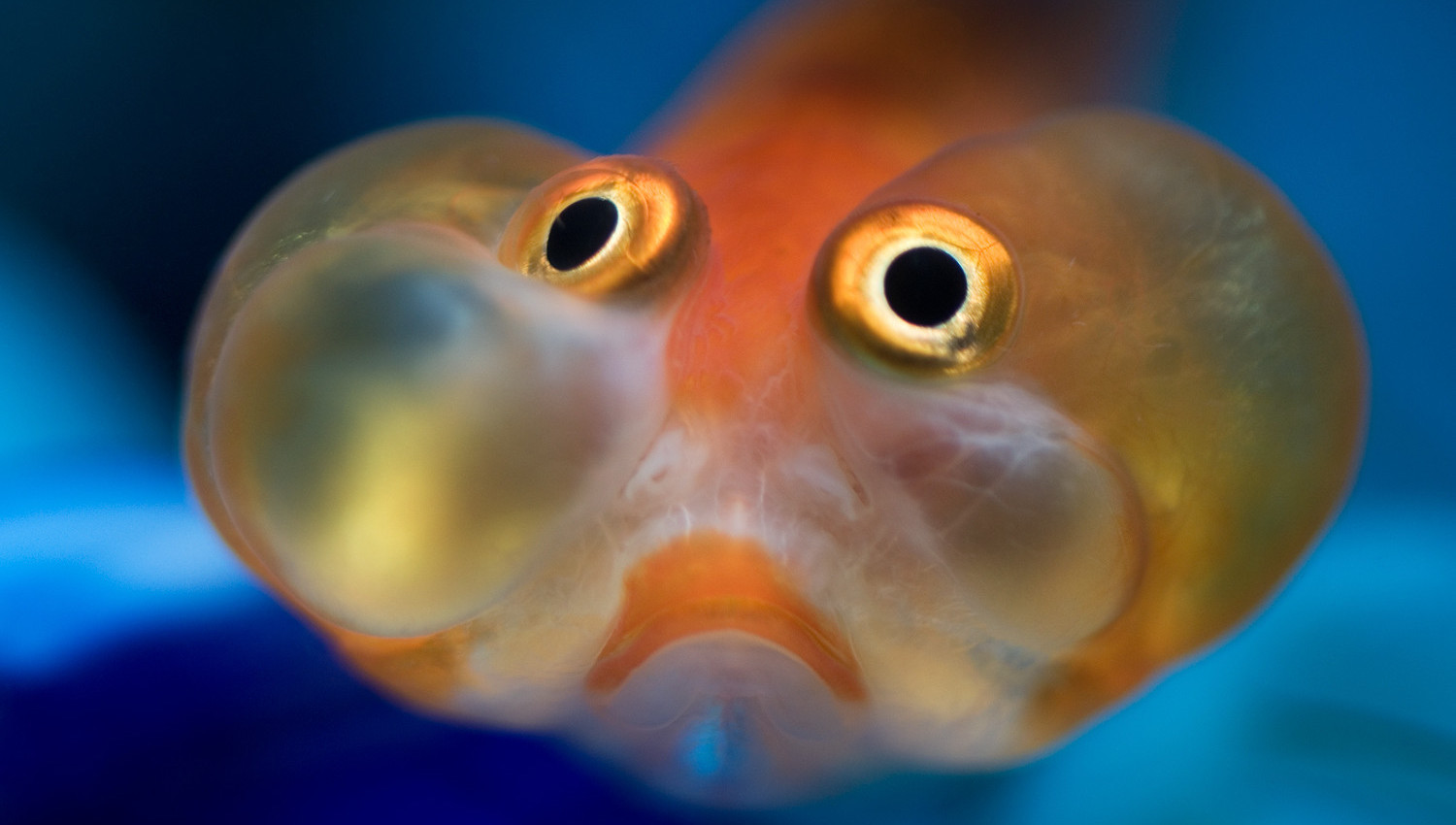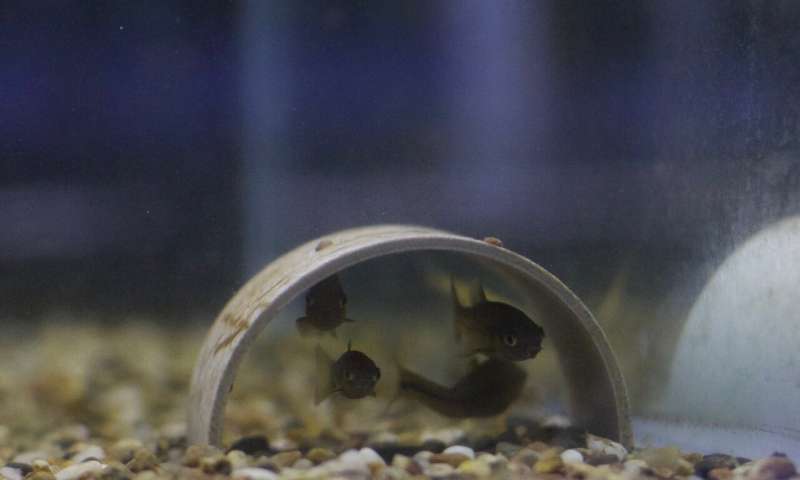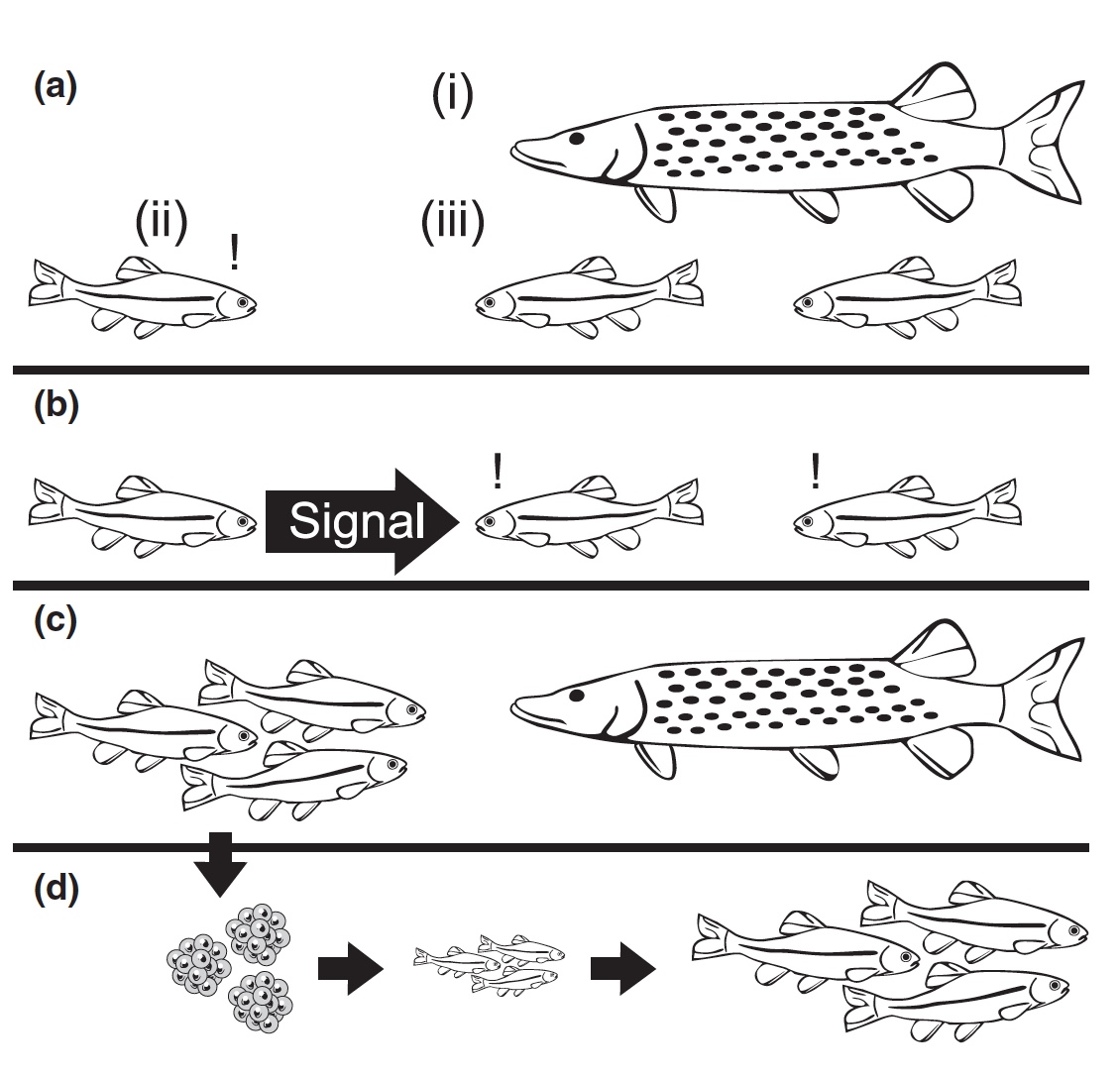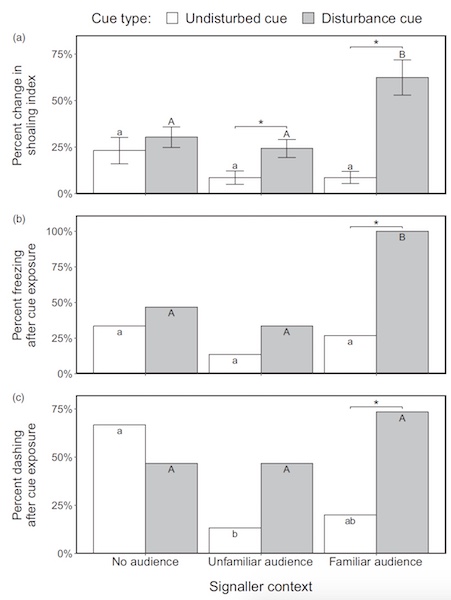Alarm! Alarm !: how fish warn their kin about danger

Friendship is known in trouble. This phrase familiar to all of us becomes a matter of life and death when it comes to wildlife, namely, socialized animals. Also a phrase would be appropriate here - forewarned means forearmed. You must have seen the sentinel among the meerkats or other animals living in groups and fearing an attack by predators. In case of danger, meerkats make a sound and all his comrades immediately hide in their burrows. But what if you're dumb like a fish? Or rather, if you are a fish. Use chemical compounds secreted by the body, of course. Scientists have found that, if necessary, some species of group fish are able to release certain substances, warning their relatives about the danger. How exactly did scientists find out how their discovery differs from the previous ones and how complex is the communication system in fish societies? For answers we dive into the research group report.
The basis of the study
The main manifestation of sociality in any living organism is communication, that is, communication between representatives of the species within the same group. Through communication information is transmitted, which is quite obvious. It can be like a call to run here, because there are a lot of tasty things, and a warning about danger and the need to run away from it.
')

Fish hiding from danger.
Roughly speaking, the reasons for communication and the information transmitted by different creatures are quite similar, but the methods of transmission differ: sound, light, gestures, excretion of chemical compounds, etc. And some of these signals cannot be perceived by another species, which is very useful if you warn the group about a predator that is nearby. Man also does not notice many of these signals. This is exactly what led to the fact that many social aspects of certain species have not been studied for decades.

Image number 1
The researchers note that there are several main components in any signaling system: context (a), voluntary signal (b), response from the receiving party (c), and benefits to the sending and receiving signal (d).
First, an individual is confronted with a specific context (information / situation), which may be due to external (i) factors (food discovery, finding a number of other individuals of their species or predators), internal (ii) factors (hunger, fear, etc.) and the fact of the presence next to the recipient (iii) signals. Thus, the signaling context consists of external stimuli, the internal state of the individual, and the target “audience” of the generated signal, that is, to whom it is aimed. Also, scientists note that these signals are voluntary and are produced by an individual of their own free will.
The symbiotic relationship between the sea bull and shrimp. One of the shrimp antennas is constantly in contact with the fish, which in case of danger hides in the hole. The shrimp, having received such a signal, is also hiding.
This moment (voluntary signal) is extremely important, since not all signals are as follows. Some signals are produced randomly depending on the context without the conscious involvement of the source of the signal. For example, the smell of a wounded individual is a signal to others that danger is near, but this signal in fact created a predator, not an individual victim. In other words, it was an involuntary signal.
The next item is the receiving party. A signal causes a reciprocal response, which may include behavioral, physiological, and even genetic changes, depending on the nature of the signal.
An equally important role is played by the benefit of the signal for the one who gives it and the one who receives it. In this case, the situation can be both mutually beneficial and aimed at benefit exclusively for the individual generating the signal. Mutually beneficial signals can be used as an important survival mechanism, and therefore pass from generation to generation through heredity and / or the training of offspring.
As scientists admit, in practice it is rather difficult to measure the intensity of a signal, its arbitrary or random nature of generation and its benefit for the generator and the receiving party. As a rule, these characteristics are already determined after the fact, that is, the degree of survival of the group, the ratio of mortality and fertility, etc. are estimated. Simply put, if a group uses signals and they are alive and well, then the signals work to their advantage. But this approach is very inaccurate and cannot answer a number of questions: does the group's behavior persist outside controlled conditions, is the behavior transmitted to offspring, etc.
If we simplify the system of signaling about danger, then we can distinguish two main contextual elements: an external factor (predator) and an audience (representatives of the same species and / or group). In this case, the intensity of the signal may vary depending on the situation. If the relatives are close enough, then the signal will be stronger. If the victim of the attack is one, and the relatives are far away, the alarm will be weak, so as not to attract too much attention from the predator.
The crows in the group are much bolder than alone, so they can even attack a bald eagle.
The composition of the audience, that is, the signal-receiving individuals, also matters. Some birds and primates increase the signal of danger, if there are representatives not just of the same species, but of a common group (family, partners, offspring) nearby.
Turning to a discussion of the inhabitants of the seas and oceans, scientists once again recall the importance of distinguishing between voluntary and involuntary signals. For example, Karl von Frisch discovered the Schreckstoff chemical compound in 1938, one of the components of which was H 3 NO. This connection is made by a wounded or killed individual, but it can not be called a voluntary and deliberate alarm signal.

Karl von Frisch
The main component of most signals in fish is urine, which is used to isolate pheromones, demonstrate dominance in a certain area, differentiate related individuals, etc. Based on this, scientists have suggested that urine may play an important role in alarm signaling.
In this study, scientists conducted tests involving black fatheads (Pimephales promelas). This type of fish leads a social lifestyle. In case of danger, they first begin to move quickly and erratically, then freeze, and then gather in tight groups and try to hide in a safe place.
The researchers conducted a series of tests in which fatheads are attacked by a predator in order to determine whether the alarms produced are voluntary, the intensity of the signal depending on the audience of the receiving individuals (their own / others) or on the presence / absence of the audience as such.
Test results
69 individuals were selected as signal generators, and 270 individuals were selected as receiving ones. All individuals were not trained in alarms, but during the tests they were in an aquarium with individuals they knew or with aliens. There were no particular physiological differences between the individuals of the generators and the recipients: weight - 0.6 ± 0.2 g, body length - 40 ± 5 mm.
The grouping rate before and after the signal was very different ( 2a ) depending on the type of signal and the type of individual generator (two-way interaction: LRT x 2 2 = 9.94, p = 0.0069).

Image number 2
By separating the data according to the type of signal and the type of generator, scientists were able to understand in more detail the relationship between these variables. Non-alarm signals (normal) did not differ between individuals of the three different categories of signal generators (LRT x 2 2 = 3.33, p = 0.19), but the alarm signals are opposite (LRT x 2 2 = 10.75, p = 0.0046). Scientists also noticed that groups of individuals that are familiar with an individual signal generator react much more actively to the alarm generated by them (LRT x 2 1 = 16.86, p <0.0001), but the groups of "strangers" react sluggishly and slowly (LRT x 2 1 = 1.28, p = 0.26).
Concerning numbness ( 2b ), a relationship was also found between the type of signal and the type of its generator (chi-square test: x 2 7 = 28.2, p = 0.0002). In the case of a normal signal, the host group often had one numb individual, regardless of the type of signal generator. However, with the alarm, the differences were as with the grouping indicator. Those who receive more often and in greater numbers are numb if the alarm signal originates from a familiar individual, rather than from a stranger (Fisher's exact test: p = 0.002) or a single (isolated) individual (p = 0.0002). Indicators of reactions to signals from outsiders and isolated individuals are quite similar, which once again confirms the importance of social connections between individuals of the same group. As they say, they trust their far better than strangers.
With an indicator of chaotic movements, the situation was even more curious ( 2c ). The group did not respond to ordinary signals emanating from generators of any type (familiar individuals, strangers, and isolated individuals). The group’s response to the alarms from familiar individuals was much stronger than to the signals from outsiders and isolated individuals.
For a more detailed acquaintance with the nuances of the study I recommend to look into the report of the research group .
Epilogue
The researchers, conducting the above tests, confirmed the fact that the alarm signals (in this case, chemical) are an important component of protection against predators for the individual generating the signal and for the individuals receiving the signal. It was also established that these signals are generated voluntarily and deliberately, in contrast to the involuntary signals from the wounded or killed individual.
In addition, the study showed that the group would be more willing to respond to alarms generated by an individual from the same group than by strangers or isolated individuals. This observation confirms the fact that there are stronger social connections within specific groups, rather than species as a whole.
This study allows a better understanding of the social structure and its fundamental elements in underwater inhabitants. The world of wildlife is a dangerous place, especially for small fish, who have a lot of hungry enemies. By forming groups, they increase their chances of survival. But if the group is blind to the dangers surrounding it, there will be little sense from the mass. That is why the awareness of each member of the group about the environment plays such an important role in the struggle for survival.
Friday off-top:
Hellish vampire squid (Vampyroteuthis infernalis), with the unexpected appearance of which not only the fish would start to sound the alarm, but also the people.
Hellish vampire squid (Vampyroteuthis infernalis), with the unexpected appearance of which not only the fish would start to sound the alarm, but also the people.
Off-top 2.0:
What will happen if you combine the trailer for the cartoon “Finding Nemo” and the sound series of the trailer for the film “Logan”?
Thank you for your attention, stay curious and have a great weekend, guys :)
What will happen if you combine the trailer for the cartoon “Finding Nemo” and the sound series of the trailer for the film “Logan”?
Thank you for your attention, stay curious and have a great weekend, guys :)
Thank you for staying with us. Do you like our articles? Want to see more interesting materials? Support us by placing an order or recommending to friends, 30% discount for Habr's users on a unique analogue of the entry-level servers that we invented for you: The whole truth about VPS (KVM) E5-2650 v4 (6 Cores) 10GB DDR4 240GB SSD 1Gbps from $ 20 or how to share the server? (Options are available with RAID1 and RAID10, up to 24 cores and up to 40GB DDR4).
VPS (KVM) E5-2650 v4 (6 Cores) 10GB DDR4 240GB SSD 1Gbps before summer for free if you pay for a period of six months, you can order here .
Dell R730xd 2 times cheaper? Only we have 2 x Intel TetraDeca-Core Xeon 2x E5-2697v3 2.6GHz 14C 64GB DDR4 4x960GB SSD 1Gbps 100 TV from $ 199 in the Netherlands! Dell R420 - 2x E5-2430 2.2Ghz 6C 128GB DDR3 2x960GB SSD 1Gbps 100TB - from $ 99! Read about How to build an infrastructure building. class c using servers Dell R730xd E5-2650 v4 worth 9000 euros for a penny?
Source: https://habr.com/ru/post/449422/
All Articles